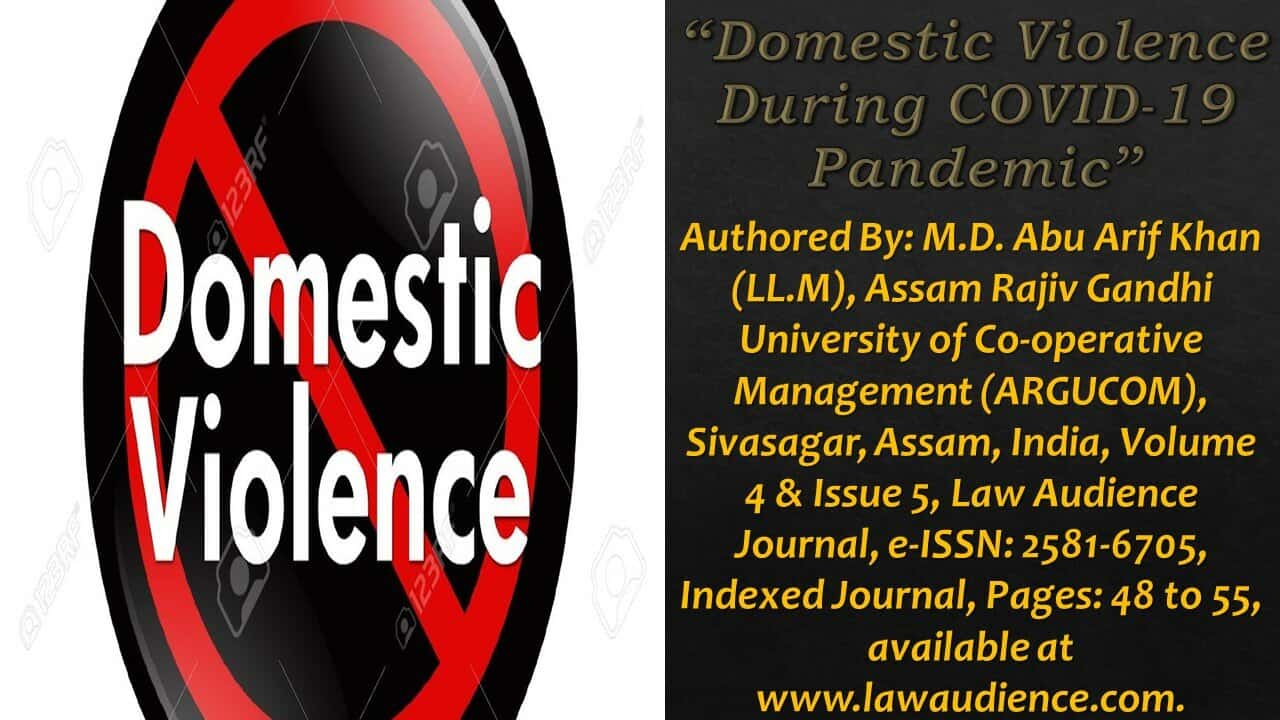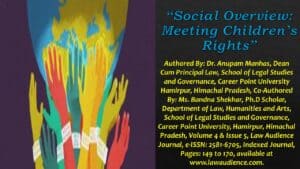Click here to download the full paper (PDF)
Authored By: M.D. Abu Arif Khan (LL.M), Assam Rajiv Gandhi University of Co-operative Management (ARGUCOM), Sivasagar, Assam, India,
Click here for Copyright Policy.
“I realise Now I am a survivor. I am a stronger woman for opening my eyes and stepping away from someone who did not respect themselves and would never respect me”————Lori.
ABSTRACT:
A human being is a social animal. The society build up by cohabitation of man and woman. In most of the society in the world the woman has been considered as weak as comparison to the man. Woman are generally in common dogma treated as born for domestic maintenance sexual pleasure, etc even in the advanced society like Europe, USA. In Indian society since the Vedic age woman are treated as second gender who born for household activities, sexual relationship and maintenance of generation by giving birth of child. Today woman live in a civilized and domestic which is based on principles of equality and freedom for all. In a civilized society there is no place for gender discrimination therefore united nations and its allied organisation has brought various international human rights norm that insist on elimination of all forms of discrimination and advocate equal rights for woman.
As such women’s year, woman decade etc are observed that led to the creation of mass awareness and sensitization of people about right of woman many steps are taken by the government in form of various policies and programme to promote the status of women and realise woman rights. But despite of all the efforts the basic issues of domestic violence remain the same. John Stuart Mill put it into his book “The subjection of woman” in 1869, that marriage should through of partnership and the family not a school of despotism but the real school of virtues of freedom.” Contrary to this woman who constitute about half of the world’s populations are the worst victim of violence and exploitation within home.
I. INTRODUCTION:
The new annexation of COVID-19 an infectious disease pandemic in the list of disease causes interpersonal behaviours change with affecting public health. The covid-19 pandemic compelled the people to remain confined in the house as a result the adult male have to spend more time within the home which triggered the interaction with the woman in the house. Since the outbreak of COVID-19, data comes out that all types of violence against women and girls, particularly domestic violence has intensified. This is the Shadow Pandemic growing amidst the COVID-19 crisis and we need a global collective effort to stop it. As COVID-19 cases continue to strain health services, essential services, such as domestic violence shelters and helplines, have reached capacity. More needs to be done to prioritize addressing violence against women in COVID-19 response and recovery efforts.
II. PANDEMIC AND GENDER-BASED VIOLENCE:
Quarantine has been an effective measure of controlling infection since the 14th century. The medieval societies were able to establish a link between the emergence of symptoms and the duration of time. The origin of the term is rooted in the health practice related to plague back in 1377 AD when ships were isolated for 30 days and land travellers for 40 days in the sea port of Ragusa. However, the earliest record of quarantine can be traced back to 532 AD. Since then, the practice of quarantine has been utilized to reduce the spread of contagious diseases. With the declaration of COVID-19 as a global pandemic, there is a mounting pressure on the governments to take measures to reduce the community spread of the disease. Hence, in the absence of a vaccine or effective treatment, going into quarantine for varying periods of time is being adopted as an option by most countries.
This has led to a drastic alteration in the day-to-day lifestyle of the individuals: Most of the work is being done from home, and efforts are being made to maintain social distance. These measures are crucial to the protection of healthcare systems. However, just like one coin has two sides, the positive efforts to tackle COVID-19 have negative consequences associated with them. These negative consequences include the risk of losing jobs, economic vulnerabilities, and psychological health issues resulting from isolation, loneliness, and uncertainty, among others. This can be regarded as the quarantine paradox. History has witnessed the weakening of the states in the face of pandemics and outbreaks. The Antonine plague of 161 AD had economically weakened the Roman Empire. The Byzantine empire too had suffered weakening of the economic infrastructure during the Justinian plague. Past researches indicate that the risk of serious psychological consequences increases with the increase in the duration of the quarantine. According to Hawryluck et al. and Reynolds et al., a longer duration of quarantine was found to be associated with increased symptoms of PTSD. Lee et al. reported that the risk of developing PTSD symptoms persisted despite home quarantine. Another downside of quarantine is the increase in cases of gender-based violence that is frequently ignored. Gender-based violence is a form of violence targeting a person based on the gender of an individual.
It is a complex phenomenon that includes combinations of sexual, physical, and emotional violence and neglect or deprivation CEDAW (Committee on Elimination of Discrimination Against Women) has defined gender-based violence as a form of violence that disproportionately affects women. Some common forms of gender-based violence include sexual violence, violence against women, domestic violence, and harmful traditional practices, such as female genital mutilation. For the present paper, the term gender-based violence has been used to denote different aspects of domestic violence against women. According to an article published in The Hindu, the National Commission for Women (NCW) recorded a twofold rise in the cases of gender violence. Several researches indicate a rise in family violence and sexual violence during and after any large crisis or disaster.
III. RELATION BETWEEN GENDER-BASED VIOLENCE AND CRISIS SITUATIONS:
Violence has generally been found to increase in the face of pandemics. For instance, Rose reported an erosion of social norms and increase in violence in Bologna, Italy, in the context of plague and natural disaster. According to UNFPA, pandemics often lead to breakdowns of social infrastructures thus compounding the already existing weaknesses and conflicts. As a result, the existing gender inequality is worsened by the pandemic situations. It also increases the exposure of children and women to harassment and sexual violence when they try to procure necessities such as water, food, and firewood. Several researches report that gender-based violence is more prevalent in HIV hyper-endemic countries. Researchers have observed a link between the prevalence of HIV epidemic and gender-based violence in India as well. A report about rapid gender analysis on COVID-19 by CARE and International Rescue had expected gender-based violence to rise amid pandemic and quarantines, Hence, the report had also recommended to prepare and build on existing services for the victims of gender-based violence. The report further emphasized on the need to strengthen online services to provide psychological support and legal aid services. According to Menendez et al. often women do not have rights over their sexual choices. Consequently, they experience sexual violence and the risk of exposure to the virus through the mail carrier. Okur emphasized that sexual and gender based violence increases during crisis situations due to breakdown in law. Thus, the victims often do not receive the adequate support, and the perpetrators get exempted from punishment. Also, according to the WHO global ethics unit, gender roles affect all aspects of an endemic including interpersonal violence.
It also emphasized the need of various services to minimize the risk of violence when people are quarantined at home or in institutions. Hence, the present research shall focus on the gender-based violence, because despite being a global phenomenon, it is highly underreported due to stigma and social pressures. Moreover, there is a lack of studies focusing on the prevalence of gender-based violence during disasters. Consequently, those responding to disasters are often not aware of the possibility of surge in the cases of gender-based violence. Therefore, they often do not prepare to deal with, thereby making the situation worse. In fact, according to John et al. these are the lessons never learnt. Therefore, we have a limited understanding toward how the victims of gender-based violence respond to the situation of the current pandemic. Hence, the present research reviews the linkages between gender violence and pandemic and also attempts to identify the potential policy responses to moderate the issue. In the past, crises have been linked with a surge in cases of gender violence. A surge in intimate partner violence was observed during other disasters such as Earthquake in Haiti in 2007, Hurricane Katrina in 2005, and Eruption of Mount Saint Helens in the 1980s due to unemployment, family, and other stressors. Even during the South Asian Tsunami of 2004, a surge in gender based violence was observed. Fisher emphasized that in the aftermath of Tsunami, several incidents of violence against women and sexual assault were reported in Sri Lanka. According to researchers, pandemics cannot be considered an exception to this. Sikira and Urassa reported an increase in wife battering in the face of the HIV pandemic due to suspicion of extramarital affairs. Recent outbreaks such as Ebola, Cholera, Zika, and Nipah have also led to an increase in the cases of domestic violence. During the Ebola virus outbreak, women and girls were especially vulnerable to violence because of the inability to escape their abuser. Moreover, the victims of violence were not recognized and were often left unattended. According to Yasmin, cases of rape, violence against women, and sexual assault also increased during the Ebola outbreak in West Africa.
IV. IMPACT OF THE COVID-19 PANDEMIC ON DOMESTIC VIOLENCE:
Among the many side effects of the Covid-19 pandemic, it has become clear that the current health crisis provided a breeding ground for an increase in domestic and intra-family violence. The concept of violence is to be taken here in the broadest sense, as defined by WHO: “the intentional use of physical force or power, threatened or actual, against oneself, another person, or against a group or community, that either results in or has a high likelihood of resulting in injury, death, psychological harm, mal development, or deprivation.” As early as the beginning of April 2020, the UN issued an alert on the increasing incidence of violence against women worldwide. In France, the incidence of violence against women is estimated to have increased by 30% during the first round of containment. This observation motivated a communication campaign on reporting tools, in particular, in pharmacies and shopping centres, which made it possible to draw attention to domestic violence. The voluntary sector had to adapt to the constraints induced by the health crisis, particularly through the introduction of new digital tools. At national level, the number of police interventions for familial discords has increased significantly during containment, even if the proportion of these interventions following a qualified offence remains low. While an overall decrease in violent incidents was recorded during the first containment, the share of spousal and intra-family violence increased on the whole compared to 2019; after an initial decrease during the first two weeks, a net increase was observed from March 30, reaching a peak in April and returning to a level similar to that of the months prior to containment. These variations are corroborated by statistical analyses of forensic medicine consultations during this period.
In addition to the effect of containment, this rising trend had already been observed for several months, following the “Grenelle” against domestic violence, one of the primary objectives of which was to help victims break the silence. During the second containment announced on October 28, victimology consultation activity decreased again, but it did not fall as massively as at the beginning of the first containment. Furthermore, the apparent decrease in other types of violence continued throughout the entire containment, probably linked to the limitation of gatherings and movements. These observations seem to reflect, after a period of adaptation corresponding to the announcement of the containment and the transition to an all dematerialized system, an apprehension of victims to go to medico legal units (UMJ) located in hospitals during the pandemic period, but also a decrease in the reporting of such violence by third parties (social workers, schools, doctors).
Violence against women tends to increase in any emergency, including epidemics. Stress, disruption of social and protective networks, increased economic hardship and decreased access to services can exacerbate the risk of women suffering violence. In the case of COVID-19, isolation, restricted movement and stay-at-home measures to contain the spread of the infection have a particularly acute impact on women. The chances of women and their children being exposed to violence is dramatically increased, as family members spend more time in close contact and household stress intensifies, and the risk grows even greater when families also have to cope with potential economic or job losses. Health services that address issues such as clinical management of rape, first-line support and basic mental health services for survivors are overwhelmed by the urgent need to counteract the effect of the pandemic. This can have particularly dramatic outcomes in countries with limited health services and financial resources, as well as in humanitarian settings. Special consideration should be given to more vulnerable groups, including women living with disabilities, who are at increased risk of domestic violence and may face further barriers in reaching the services they need, such as social assistance and home care, due to curfews and social distancing or restrictions on movement. Displaced and refugee women, and women living in conflict-affected areas are also particularly vulnerable due to high population density, close proximity in living conditions; poor water, sanitation and hygiene; and limited health, social and protection services.
V. CONCLUSION:
Domestic violence against woman is a century’s old practice justified in the name of religion, culture, society or primarily. In all societies to a greater or losser degree, woman is subjected to verbal emotional, physically, sexually and psychological abuse in the homes and work places. Violence is not only a violence of human wights of woman but something that impairs their development strict legislation, with good mechanism for implementations, proper education, awareness, tolerance can keep the violence at bay.
Cite this article as:
M.D. Abu Arif Khan, “Domestic Violence During COVID-19 Pandemic”, Vol.4 & Issue 5, Law Audience Journal (e-ISSN: 2581-6705), Pages 48 to 55 (9th January 2023), available at https://www.lawaudience.com/domestic-violence-during-covid-19-pandemic/.
Footnotes & References:
- The Domestic violence Act, 2005: S.P. Sen Gupta, Kamal Law House, 1st edn. 2011.
- D.D. Basu, introducing to the Constitution of India, New Delhi: Prentice Hall of India Pvt. Ltd.
- O.P. Gauba, An introduction to Political Theory, 3rd ed. New Delhi: MacMillian India Ltd.
- A Brief History of India: Spectrum, 2019 edn.
- Crime in India, Ministry of Home Affairs, “National Crime Record Bureau (2019)”. Volume-1. 15) United Nations Children Fund. “Domestic Violence against Women and Girls”. Innocent Digest, No. 6, 2000.
- Crime Prevention from Wikipedia, The Free Encyclopaedia.
- Encyclopaedia of Indian Women through the Ages.
- The Hindu
- The Assam Tribune
- Yojna




